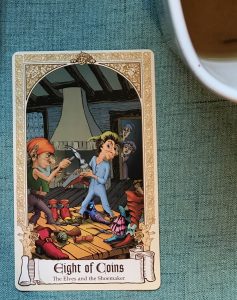 Tarot “works” because of associations – whether that’s the story attached to a fairy tale in a themed deck, the Catholic imagery of countless decks, or the subtler reference to the character of a specific fandom.
Tarot “works” because of associations – whether that’s the story attached to a fairy tale in a themed deck, the Catholic imagery of countless decks, or the subtler reference to the character of a specific fandom.
Today I’m going to introduce a few categories of associations. None are essential for beginners, and maybe none are important in general (one of the beauties of non-dogmatic tarot is that it centers around what works for each practitioner), but they’re all examples of things my mind has wrapped around and that helped create another set of “hooks” for my memory and imagination to dig into.
Numerology
Numerology is way less slick than I thought it was as a child.
I was the sort of kid who “played stories” and made up systems of magic that my fantasy-writing adult self still wishes I’d kept notes on. To see if they were as good as I remember.
Numerology (at least, the reaching a number to work with, which is 50% of what I do with it) is pretty straight-forward.
Each numeral, 0-9, has a meaning or set of associations. If you have a number containing multiple digits (e.g., 426), you add them (4+2+6=12 –> 1+2=3, this number’s numerology value is 3). Super simple.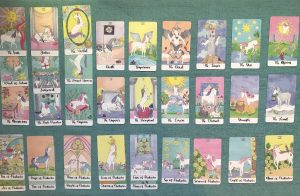
In this way The Fool (Key-0) is a group of one, The Wheel of Fortune (Key 10) and Magician (Key 1) are joined – unexpectedly, to me – by The Sun (Key 19: 1+9 =10 –> 1+0=1), and so-on.
This picture includes one set of minors, since they have numbers, too, and the court cards can have numbers by implication — if we continue counting after the 10.
Grouping
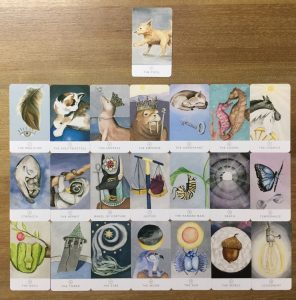 I saw this first in a book my first year of study, but went the deepest with my tarot teacher Lindsey Mack (of Tarot for the Wild Soul).
I saw this first in a book my first year of study, but went the deepest with my tarot teacher Lindsey Mack (of Tarot for the Wild Soul).
She has a very encouraging approach to tarot based on trauma-awareness and the insistence that there are no “good” or “bad” cards.
In this method, one sets aside The Fool (Key-0 card) and lines the remaining 21 majors into 3 rows of 7, drawing a narrative connection within each row that helps define part of the soul’s journey or development through the majors as a path of growth.
Number Matching
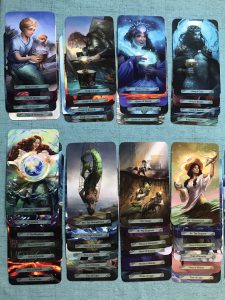 A more-experienced person might have come across an official name for this concept. I just came up with this one because I needed a way to talk about it. (Yay for flexible language doing its job.)
A more-experienced person might have come across an official name for this concept. I just came up with this one because I needed a way to talk about it. (Yay for flexible language doing its job.)
In this setting, you look only at the ones-place: the last digit in a number (if it contains more than one) and create sets based on this. You begin comparing the meaning and similarities of grouped cards. What makes them fit as a set.
This picture shows the 1-4s, including the court cards as you could continue counting them after the 10-cards. (All these groupings I expect to expend on in their own post, eventually.)
Enneagram
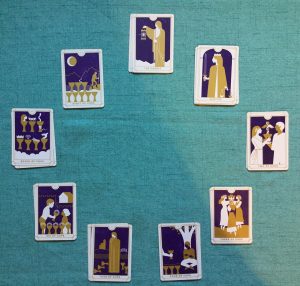 As a bit of a subset to the number matching, if one is familiar with the personality types or study of the Enneagram, it can be super-interesting to build a grid matching the ones-place with the #s 1-9 of the enneagram diagram, and compare/contrast the way these concepts line up with the personalities that share the cards’ final number.
As a bit of a subset to the number matching, if one is familiar with the personality types or study of the Enneagram, it can be super-interesting to build a grid matching the ones-place with the #s 1-9 of the enneagram diagram, and compare/contrast the way these concepts line up with the personalities that share the cards’ final number.
These particular cards are good examples of their types:
- Justice (Key 11) – enneagram 1s are often know for their drive for fairness
- Two of cups – enneagram 2s often seek to meet the needs of themselves and others through relationship
- Three of cups – enneagram 3s can often be described as the life of the party
- Four of cups – enneagram 4s are introspective, and this isn’t being distracted by one more thing – cup – being offered
- Five of cups – enneagram 5s, among other, more defining characteristics, can be pessimists, ant this card pertrays someone focusing on the spilled cups over those still upright
- Six of cups portrays an idealized youth – many enneagram 6s have an idea of how society should work, an ideal they both seek and challenge
- Seven of cups is a terrific visual of how many enneagram 7s see the world: a myriad of opportunities and choices
- Eight of cups represents a leaving, and one characteristic of some enneagram 8s is the willingness to leave behind what (or who) doesn’t fit them, or the person they’re striving to be.
- The Hermit (Key 9) – enneagram 9s are known to be conflict-avoidant, and will happily avoid society when if gives them more opportunity to avoid conflict.
It’s not a perfect system, this lining up of card numbers and enneagram numbers, but it allows (again) for more “hooks” and attachments between ideas. Since this personality construct was my first attachment of numbers and meaning, it was a very natural shift to see how much and where these numbers lined up with “established” meanings.
More Connections
Each of these groupings is an opportunity to think about how the cards relate in a way that doesn’t involve the direct analysis of a seeker (yourself or another). Once the tarot-curious start to memorize the meanings of individual cards, or – equally valid – work with a meanings-book, they can quickly find that their interest or stamina is stronger than their imagination when it comes to the cards.
That is, they may want to work more with their deck, but be out of ideas that let them practice non-rote learning.
Here are a few suggestions to keep you going:
- Take your Card of the Day (an exercise you’ve probably already heard of. I’ll link mine when I eventually write about it 😉 ) and shuffle it back into the deck. Re-find it (as many times as you’re interested in practicing) and brainstorm connections between it and the cards immediately above and below it in the deck. [I first got this exercise from Holly Easley in the Facebook group that goes along with her Wildly Tarot podcast.]
- Expect to journal about everything (here is a blog post/video combo with a useful PDF example of how you might set up your own tarot journal. Just print out the pages that apply to you or that you’d like to try. It can be overwhelming at first (to see all the *options*) but don’t feel like you have to do everything all at once.)
- If you don’t know what to journal about, you can visit Instagram and find all sorts of monthly challenges with a prompt for each day of the month. Or, you can Google that idea to get lists of questions. Choose a question that speaks to you, write it at the top of your journal page and draw a card to write about in the context of that prompt.
- One really useful way to journal a card is to go past collecting “meanings” from your various source texts.
- By this, I mean: search your memory and life-experience for elements that tie in with the meanings you’re learning or uncovering. This builds a personal lexicon, and activates a different part of your memory, anchoring the cards’ meanings to more connections. (The point of this post, in case I haven’t made that clear enough yet.)
- More connections hint at a greater probability of recall in a reading (later) situation.
A little more about this memory-hooks, thing: stories, poems and song lyrics completely count as life-experiences/connections. Anything that has a hook in your life, and connections where “the inside is bigger than the outside.”
Because a tiny hook (a character’s name, say) carries a load of information that isn’t necessarily all in words (yet), practicing and making these connections shows your brain you already know how to work with symbols and meanings beyond/outside of language.
Take for an example the word, “Grandma.” Whatever that word means to you – positive or not – it carries more than a mere collection of letters and sound to a single word.
That’s what the cards grow into, and if you can show your brain that you’re already doing that, I think it helps the process.
The Core Idea in All of This
We can build familiarity with our decks through time, and exposure, and variety. The magic happens when we make connections between the cards and reality in real time. Sometimes it’s as organic as the face on a card looking familiar and sparking a memory or association.
All this is real, and useful and can help us on our learning journey.
Decks pictured:
- The Fairytale Tarot by Karen Mahony, Irena Triskova (Illustrator), Alex Ukolov (Illustrator)
- The Crystal Unicorn Tarot by Pamela Chen and Lisa Higuchi (Illustrator)
- White Sage Tarot by Theresa Hutch
- Mermaid Tarot by Leeza Robertson, Julie Dillon
- Everyday Tarot by Brigit Esselmont and Eleanor Grosch (Illustrator)